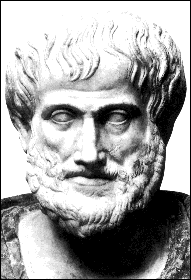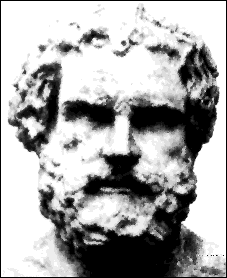
The art of khemeia was developed by the Greeks over a period of 1000 years between 700 BC and 300 AD. They were concerned with a philosophical science, and whether, as Thales (640-546 BC) speculated, a substance could be transformed into another, which had no resemblance to the previous substance.

This lead many philosophers of the time to conclude that everything in the universe comprised essential elements - fire, water, air and earth – a theory which was to be accepted for many centuries.
Aristotle (384-322 BC)
(see left) proposed the Fifth Element ‘Quinta Essentia’,
the origin of ‘quintessence’, which describes something in its purest form.
Aristotle: image reproduced from http://dbhs.wvusd.k12.ca.us/gallery/html
Aristotle:
"To Thales the primary question was not what do we know, but how do we know
it."
Quoted in Mathematical

The second main problem, which the
Greek khemeia philosophers tried to rationalize, was the question of how many
divisions could be made of a solid, and
whether it was an infinite number.
Leucippus and Demoncritus (see right) (c. 440 BC) suggested that there would be
a size at which no more subdivisions were possible.
This was named ‘atomos’, meaning ‘indivisible’, and marked the
beginning of practicing alchemy.
Demoncritus: image reproduced from http://dbhs.wvusd.k12.ca.us/gallery/html
Back to home page